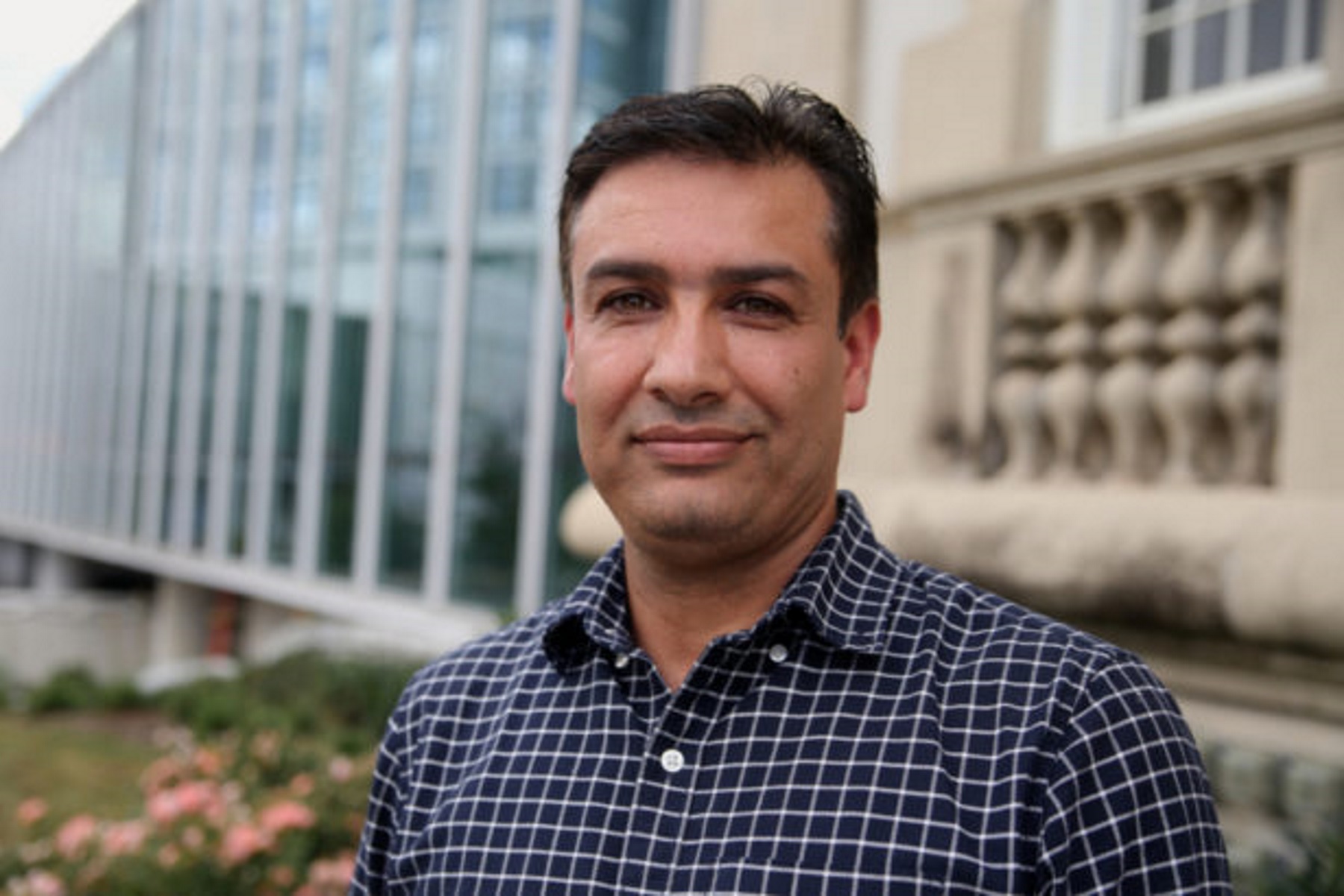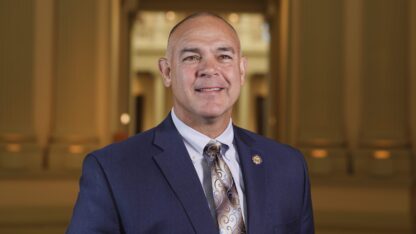“I came with a big dream,” Ghaini said. “It was a hard decision. But I thought I would pass the exams — and get into residency.”
His medical journey shows the many roadblocks – and the flickers of possibility – that foreign-born physicians can experience in seeking to practice in the U.S., a country with a doctor shortage that will only grow in future years.
The American Medical Association (AMA) said that, as of last year, 18 percent of physicians and medical residents in the U.S. in patient care were born in other countries. Georgia’s percentage of foreign-born doctors is similar, at 17 percent.
Ghaini settled north of Atlanta, near where his wife’s uncle lived in Johns Creek, and ordered a set of textbooks. In 2011, the year after he arrived, he passed his first U.S. Medical Licensing Exam, one of four tests that medical students must pass to practice medicine. Two years later, he passed a second. Much of the material he had already learned many years ago while training in Iran. But this was to be expected, he was told. Over the next three years, he passed the final two exams he needed in order to apply for residency, the final step before he could return to medicine.
Two years ago, Ghaini applied to nearly 100 different residency programs.
The process of applying to that many programs was as time-consuming as it was expensive — costing more than $5,000. But with the U.S. matching process as competitive as it is for medical school graduates, especially ones who studied outside the country, Ghaini knew it was necessary.
He didn’t expect to hear from every school. He presumed, though, that at least a few hospitals would arrange interviews.
But as fall turned to winter, no one reached out. And as winter turned to spring, he didn’t match with a residency program. While he was dismayed, he would not be deterred. He would just have to try harder next year — even if his dream was deferred.
Big Doctor Shortages Loom
From the suburbs of Atlanta to farming communities outside Albany, Georgia faces a growing shortage of physicians. One in three counties don’t have any pediatricians. And six of 159 counties don’t have a doctor of any kind.
Nationally, the doctor shortage is on track to worsen by 2030, in part because the U.S. population is projected to grow during those years. Not only could the number of Americans over age 65 grow by 50 percent, a third of all current doctors will soon be senior citizens. With doctors experiencing burnout at unprecedented rates, forcing some into early retirement, the Association of American Medical Colleges expects to see a shortage of up to 120,000 physicians by 2030.
While lawmakers have stretched the shrinking supply of doctors with the help of telemedicine, the hospitals responsible for training the next generation of doctors are in a bind.
More people are trying to practice medicine than a generation ago. But Congress hasn’t increased funding for residency programs, the three-year training requirement to receive a medical license, leaving hospitals without the budget to pay more trainees. This year, nationwide, only 52 percent of the 56,000 medical school graduates who applied for residency slots were matched to one, according to the National Resident Matching Program.
Faced with a shrinking force of doctors, some health care experts believe that foreign-trained doctors such as Ghaini could fill a portion of that gap. There could be as many as 65,000 foreign-trained doctors living in the U.S. without American medical licenses, according to the Massachusetts Immigrant and Refugee Advocacy Coalition. Overall, international residency applicants like Ghaini only “matched” for residency programs 40 percent of the time, compared to 64 percent of medical students who trained in the U.S.
Foreign-trained doctors believe that residency programs don’t value those who receive a medical education from outside the U.S.
“It’s harder now for international medical graduates to get residencies here,’’ says Dr. Dolapo Babalola, a Nigerian-born Morehouse School of Medicine professor who went to medical school in Guyana.
In lieu of expanded residency programs, some doctors believe Georgia should create a new kind of medical license for “assistant physicians” that could serve under supervising doctors. They consider it a short-term fix to allow foreign-trained doctors who don’t match into a residency program to provide primary care for patients seeking treatment for chronic medical conditions like diabetes, obesity and high blood pressure.
“Theoretically, these doctors are clinicians,” said Dr. Gulshan Harjee, a Tanzanian-born internist who co-founded a free clinic based in DeKalb County that serves mostly immigrants and refugees. “Because they haven’t had a residency, they can’t be employed. Could [someone like Ghaini] handle patients in rural Georgia? Absolutely.”
A Medical Journey
At the age of 20, following a required stint in the military, Ghaini began to study medicine. He spent seven years in medical school. (Iranian students typically don’t go to a separate university for a bachelor’s degree.) After that, he was required to practice in a small rural village called Kahbr, 12 hours south of Tehran. Another doctor taught him the ropes in the first two months. After that, he was the clinic’s only on-call doctor, a position that he held for two years.
“You were on 24 hours a day,” he said. “These people didn’t have any [other] kind of health care.”
In 2003, Ghaini returned to Tehran to see patients at a community health clinic. In his spare time, he worked for a local soccer club tending to injured players. Three years later, he stepped foot inside Sina Hospital for his orthopedic surgery residency. He figured that he would be done training in 2009.
But nearly a decade later, he found himself applying to U.S. residency programs for the second year in a row. After not matching in 2016, he kept studying and routinely volunteered at Harjee’s health clinic in Clarkston to stay involved in a clinical setting.
On breaks from his day job as a stem cell researcher at Emory University’s medical school, he pulled out his smartphone to answer test questions on the U.S. Medical Licensing app. After work each day, he would continue his studies, usually after dinner, until just before midnight.
When he applied for residency again he again paid thousands to scatter applications across the country. He interviewed with one hospital in Corpus Christi, Texas. But the program didn’t offer Ghaini a spot. He noticed that some programs wouldn’t accept his education because too much time had passed since he completed medical school. Other programs, meanwhile, wouldn’t acknowledge the hours he spent observing or volunteering in medical settings.
“I never thought it would take seven years,” said Ghaini, who has since earned his citizenship. “If I knew this was the situation, I would’ve gone back to medical school right away. Now I can’t afford to go back medical school.”
Proposal For Assistant Physicians
Like Ghaini, six other foreign-trained doctors each express the need for a pathway to practice medicine in Georgia.
Sadia Javaid, a foreign-trained doctor who lives in Georgia, believes the idea of assistant physicians would not only help people like her — but also rural Georgians who travel long distances to get medical care.
I don’t know what’s here for me in the future. I don’t want to give up.
Iraj Ghaini
A regular volunteer at Harjee’s clinic, she points to states like Missouri, where more than 140 medical school graduates practice under the supervision of a doctor, as an example of what Georgia needs. Similar programs have also passed Legislatures in Arkansas and Kansas. Programs in California and Minnesota have already helped scores of foreign medical graduates transition into residency programs.
Lilburn resident Shama Panjwani, who worked as a doctor in India and is now studying at Emory University to become a nurse, says those kinds of efforts would prevent people like her from leaving the field.
Fatima Jaffer, a Pakistani medical school graduate who didn’t match into a residency program, said, “They need to utilize our knowledge. Half of the time it’s about prevention. Let us see people. Let us talk to patients. Let the supervising doctor sign the prescription.”
But the American Medical Association, AAMC and other influential medical groups oppose the license of assistant physicians because they fear it might compromise patient safety.
Several years ago, Dr. Harjee urged the Medical Association of Georgia to support the assistant physician model. Despite a MAG task force’s recommendation for the new licensure category, some of the group’s members have expressed concerns that the assistant physicians might negatively impact primary care physicians. In a statement, MAG President Dr. Frank McDonald said the association does not have a formal policy on assistant physicians and will continue to study the issue.
Republican state Sen. Kay Kirkpatrick, an orthopedic hand surgeon, says she could support the study of the assistant physician license concept if it specifically addressed the rural physician shortage. “We don’t need more docs in our bigger cities,” Kirkpatrick said.
“We must balance carefully our need for providers and the safety and care of our citizens,” said state Rep. Jodi Lott, a Republican from Evans who worked as a registered nurse and now owns a physical therapy practice. “I do believe that rural Georgia could benefit from their talents and experience in a supervised position.”
‘I Don’t Want To Give Up’
As Ghaini readies for a third round of residency applications, he sometimes wonders if coming to America was worth it.
He loves this country for the freedom it provided his wife to pursue a career as an IT engineer and for the educational opportunity it afforded his two children.
But he also second-guesses his choice.
While Ghaini hasn’t given up on his dream of practicing medicine in America, he will apply to fewer residency programs in 2018. Moreover, he’s considering the possibility of a job as a physician assistant, a medical professional who handles many of the routine tasks that physicians usually perform without many of the privileges of being a doctor. Even that path, however, has been surprisingly difficult.
He is now taking chemistry and calculus courses with undergraduate students half his age. He took and passed these courses in his early 20s, but some P.A. programs only accept coursework completed in the past decade.
On several occasions, Ghaini has heard his 11-year-son say that he didn’t want to be a doctor after watching his dad struggle to break into the medical field. When Ghaini speaks to his four brothers in Iran, he doesn’t know how to describe the fact that his dream of being a doctor again is falling out of reach. He’s trying, he tells his brothers; that everything is a process. They pray for the best. And so does he.
“I don’t know what’s here for me in the future,” says Ghaini, now 46. “I don’t want to give up. I don’t want to be far from my field — this is the field where I can be most useful. I’m hoping something changes.”
Max Blau writes narrative and investigative stories for newspapers, magazines and digital media outlets. His award-winning stories have appeared in the Atlanta Journal-Constitution, the Boston Globe, CNN, the New York Times and Politico. A recent graduate of the University of Georgia’s narrative nonfiction M.F.A. program, Max now works as a freelance journalist and is based in Atlanta. Check out Max’s writing at www.maxcblau.com.
PART ONE OF OUR SERIES: Doctors born in India filling medical gaps in Georgia
This article first ran on the Georgia Health News website







